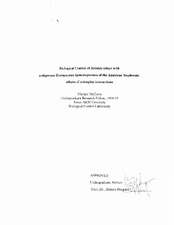| dc.description.abstract | In some systems, agricultural producers implement an augmentative biological control strategy by releasing large numbers of native hymenopteran parasitoids to reduce insect herbivore densities, which favors the grower economically. These biological control agents permit reducing pesticide use on food and fiber crops, which has many repercussions: lower costs for the grower and consumer; production of a healthier, higher quality food item; and less collateral damage on nearby organisms and ecosystems. Moreover, alternative pest management strategies avoid the serious problems associated with relying on pesticides as the sole control measure: first, target pests develop pesticide resistance, rendering chemical control more costly and less reliable, and second, minor pests surge and become economically destructive when their natural control agents are wiped out by pesticides.
However, pesticides can be easily applied in most situations, while the use of parasitoids in augmentative biological control is currently restricted to a much more limited range of situations where experience or research has proven their efficiency. While biological control has been practiced since the last century, the research community has much to learn about the underlying mechanics. Much basic biological and ecological work remains to be done to promote the use of biological control agents as reliable pest controls across a broad spectrum of agroecosystems.
Sweet potato whitefly, Bemisia tabaci (Homoptera:A1eyrodidae) wreaks economic damage on a wide range of field and greenhouse crops in the tropical, subtropical, and warmer temperate zones. Its geographic distribution is worldwide; in the Americas it is distributed across both continents except where limited by cool temperatures. It attacks field, vegetable, and greenhouse crops: cotton, alfalfa, peanuts, cabbage, broccoli, cauliflower, melons, squash, cucumber, tomato, pepper, and potatoes, as well as ornamental crops such as poinsettias and hibiscus. It transmits at least 20 viruses (Byrne et.al., 1990) causing over 40 diseases of vegetables, ornamentals, and field crops (Brown & Bird, 1992). In the U.S., every state in the sunbelt is affected. In the Southwest Bemisia is arguably the single worst agricultural pest; in 1991, a particularly bad year, damage estimates in Texas alone reached about $250 million and around 6500 jobs lost (Bready 1991).
Species of parasitic wasps in the genus Eretmocerus (Hymenoptera: Aphelinidae) occur naturally across the U. S. and show considerable promise as control agents of Bemisia (Powell and Bellows, 1992; Butter and Vir, 1989; Bellows and Arakawa, 1988; Gerling, 1986; Sharaf and Batta, 1985; Shoshana and Gerling, 1985; Rose and DeBach, 1982; Gerling, 1966). Scientists at several different universities and research institutes in the American Southwest., including researchers at Texas A&M, are currently studying Eretmocerus spp. and a related genus, Encarsia spp.
Understanding the foraging strategies and reproductive patterns of these two genera of parasitoids would shed light on their efficiency in different agroecosystems, indicating when and why they are likely to colonize crops and regulate pest populations. We could then better estimate what crops and under what conditions these two species would be suitable for biological control of whitefly. Field trials could verify this information and the techniques could then be disseminated to growers. Bemisia tabaci is a very serious pest in the southern regions of the U.S., and identifying an indigenous natural enemy whose control activities could be promoted through human intervention would be a significant gain for growers. | en |


